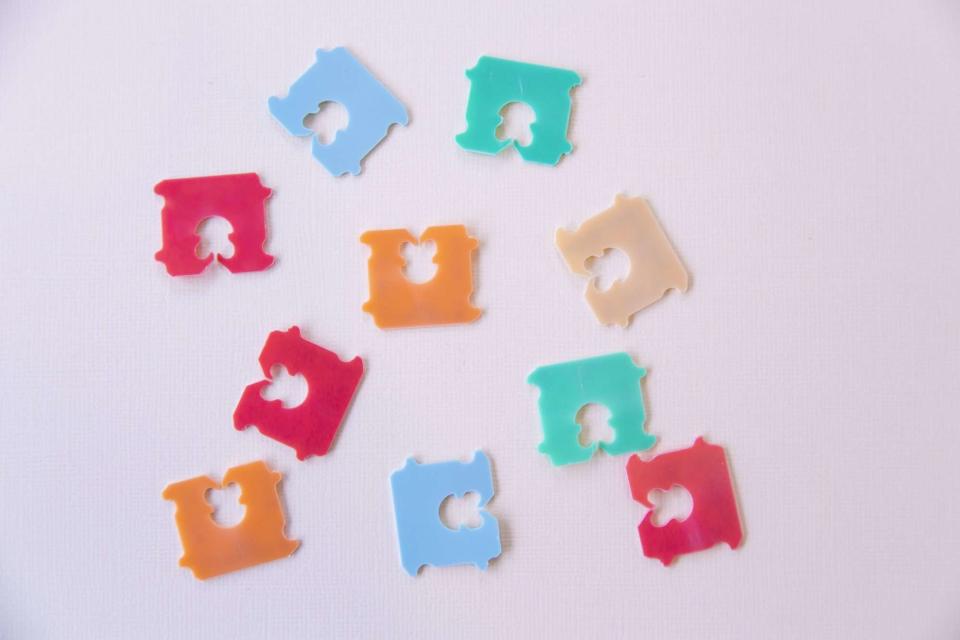What Do The Colorful Tags On Loaves Of Bread Mean?
We got the scoop from a bread expert.

Whether it's a regional chain or local mom-and-pop shop, grocery stores are highly organized operations, as are the suppliers that stock them. As consumers, we aren't privy to much of this behind-the-scenes magic; it is simply evident in the meticulous rows of produce and products lining the shelves. But if you look a little closer, you might spot clues as to the origins and freshness of food on display and the fact that it's constantly refreshed.
In the bread aisle, for example, you can see hints of this impressive workflow in the form of the color-coded ties and tags that secure loaves of sliced bread and packages of buns, English muffins, bagels, and more. Most shoppers might not give the bread tag or tie's color a second thought, but it turns out that the hue has a purpose.
What Does A Bread Tag Or Tie's Color Mean?
According to Harry Peemoeller, senior instructor of bakery and bread studies at Johnson & Wales University in Charlotte, N.C., bakeries use specific bread tie and tag colors to help them keep track of each batch of bread, buns, or rolls they produce. In the most basic terms, the color corresponds to when the bread was packaged or sliced, and can both help the bakery keep tabs on batches and help suppliers quickly identify which loaves are fresh and which are past their prime and should be removed from shelves.
Related:Our Most Popular Bread Recipes of All Time
It's common for bakeries to use a color-coding system that matches the day of the week the bread was packaged. Typically the first letter of the color will correspond to the order of the day of the week. For example, blue might correspond to Monday, orange to Tuesday, red to Wednesday, white to Thursday, yellow to Friday, and so on. This could be an interesting convention to learn as a shopper, but unfortunately the code is not used in the exact same way across all bakeries.
Can The Color-Coding System Help Shoppers?
Committing any kind of color code to memory as a consumer is probably not a worthy exercise, Peemoeller says. Because the color system is not the same at each bakery—i.e., one bakery's blue tag might mean something different at another bakery. It's not a system that is designed to be specifically helpful to shoppers.
Other examples from Peemoeller of how the system isn't one-bakery-fits-all: A bakery might bake multiple batches of the same kind of bread per day, each with a different colored tag. Or, some types of bread, like potato rolls, may last longer than others, and therefore may only be delivered twice a week while bread with a shorter shelf life is delivered four times.
On the other hand, the bakery and the supplier do rely on the tag or tie's color. It's a quick way for suppliers to remove less-fresh loaves from the shelves and move others to the front of the display. If something goes wrong with a batch of bread, the color and code on the tag can help the bakery retrace its steps and assess the issue of that particular batch.
How To Select The Freshest Bread In The Store
Instead of looking at the bread tag or tie color, shoppers should focus on the sell-by date, Peemoeller says. If a loaf at the front of the bunch says October 1 and there's one at the back that says October 6, grab the one that will work best for your purposes.
Related:Southerners Know the Best Kind of Bread for an Everyday Sandwich
Shoppers can also look at the ingredient list and avoid breads that contain mold- and bacteria-inhibitors, which help them last longer. These loaves will be just fine to eat, but might not be as technically fresh as a loaf that does not contain enzymes (because bread with the inhibitor can last longer, it might be older). If you'd like to avoid such ingredients, you can look for 'calcium propionate' on the label and stear clear if it's in the list, Peemoeller says.
To get as close to homemade-fresh as possible (here's how to make the best bakery-style bread at home), Peemoeller recommends choosing an unsliced loaf from the bakery section of your store and getting it sliced on-site or slicing it at home with a serrated knife.
How To Keep Bread Fresh At Home
Keep your bread, whether from the bakery section or the bread aisle, fresh at home by wrapping what you don't plan to eat within a few days in plastic wrap, putting it in a freezer bag and storing it in the freezer, says Peemoeller. When you're ready to eat the frozen slices, remove them from the freezer and leave them out on the counter overnight. They'll be ready to eat in the morning. Do not store your bread in the refrigerator. It will lose moisture and taste stale faster.
For more Southern Living news, make sure to sign up for our newsletter!
Read the original article on Southern Living.
